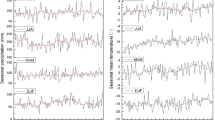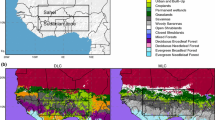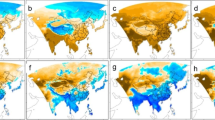Abstract
Albedo plays an important role in land–atmosphere interactions and local climate. This study presents the impact on simulating regional climate, and the evolution of a drought, when using the default climatological albedo as is usually done in regional climate modelling, or using the actual observed albedo which is rarely done. Here, time-varying satellite derived albedo data is used to update the lower boundary condition of the Weather Research and Forecasting regional climate model in order to investigate the influence of observed albedo on regional climate simulations and also potential changes to land–atmosphere feedback over south-east Australia. During the study period from 2000 to 2008, observations show that albedo increased with an increasingly negative precipitation anomaly, though it lagged precipitation by several months. Compared to in-situ observations, using satellite observed albedo instead of the default climatological albedo provided an improvement in the simulated seasonal mean air temperature. In terms of precipitation, both simulations reproduced the drought that occurred from 2002 through 2006. Using the observed albedo produced a drier simulation overall. During the onset of the 2002 drought, albedo changes enhanced the precipitation reduction by 20 % on average, over locations where it was active. The area experiencing drought increased 6.3 % due to the albedo changes. Two mechanisms for albedo changes to impact land–atmosphere drought feedback are investigated. One accounts for the increased albedo, leading to reduced turbulent heat flux and an associated decrease of moist static energy density in the planetary boundary layer; the other considers that enhanced local radiative heating, due to the drought, favours a deeper planetary boundary layer, subsequently decreasing the moist static energy density through entrainment of the free atmosphere. Analysis shows that drought related large-scale changes in the regional climate favour a strengthening of the second mechanism. That is, the second mechanism is stronger in a drought year compared to a normal year and this difference is larger than for the first mechanism. When both mechanisms are active, the second mechanism tends to dominate across the model domain, particularly during the 2002 drought period. The introduction of observed inter-annual variations in albedo produces an enhancement of the first mechanism and a weakening of the second mechanism during the onset of the drought.














Similar content being viewed by others
References
Alessandri A, Gualdi S, Polcher J, Navarra A (2007) Effects of land surface–vegetation on the boreal summer surface climate of a GCM. J Clim 20:255–278. doi:10.1175/JCLI3983.1
Betts AK, Ball JH (1998) FIFE surface climate and site-average dataset 1987–89. J Atmos Sci 55:1091–1108
Blyth EM, Evans JG, Finch JW, Bantges R, Harding RJ (2006) Spatial variability of the English agricultural landscape and its effect on evaporation. Agric For Meteorol 138:19–28. doi:10.1016/j.agrformet.2006.03.007
Bonan GB (2008) Forests and climate change: forcings, feedbacks, and the climate benefits of forests. Science 320:1444–1449. doi:10.1126/science.1155121
Cai W, Cowan T, Briggs P, Raupach M (2009a) Rising temperature depletes soil moisture and exacerbates severe drought conditions across southeast Australia. Geophys Res Lett 36:L21709. doi:10.1029/2009GL040334
Cai W, Cowan T, Raupach M (2009b) Positive Indian Ocean dipole events precondition southeast Australia bushfires. Geophys Res Lett 36:L19710. doi:10.1029/2009GL039902
Charney J, Quirk W, Chow S, Kornfield J (1977) Comparative study of effects of albedo change on drought in semi-arid regions. J Atmos Sci 34:1366–1385
Chen F, Avissar R (1994) Impact of land-surface moisture variability on local shallow convective cumulus and precipitation in large-scale models. J Appl Meteorol 33:1382–1401
Cook BI, Bonan GB, Levis S (2006) Soil moisture feedbacks to precipitation in Southern Africa. J Clim 19:4198–4206
Csiszar IA (2009) ISLSCP II NOAA 5-year average monthly snow-free albedo from AVHRR. ISLSCP initiative II collection. Data set. Available on-line [http://daac.ornl.gov/] from Oak Ridge National Laboratory Distributed Active Archive Center, Oak Ridge, Tennessee, U.S.A. doi:10.3334/ORNLDAAC/959
Dirmeyer PA, Shukla J (1994) Albedo as a modulator of climate response to tropical deforestation. J Geophys Res 99:20863–20877
Eltahir EAB (1998) A soil moisture rainfall feedback mechanism 1. Theory and observations. Water Resour Res 34:765–776
Evans JP, McCabe MF (2010) Regional climate simulation over Australia’s Murray-Darling basin: a multitemporal assessment. J Geophys Res 115:D14114. doi:10.1029/2010JD013816
Evans JP, Pitman AJ, Cruz FT (2011) Coupled atmospheric and land surface dynamics over southeast Australia: a review, analysis and identification of future research priorities. Int J Climatol 31:1758–1772. doi:10.1002/joc.2206
Evans JP, Ekström M, Ji F (2012) Evaluating the performance of a WRF physics ensemble over South-East Australia. Clim Dyn. doi:10.1007/s00382-011-1244-5
Findell KL, Eltahir EAB (2003a) Atmospheric controls on soil moisture-boundary layer interactions. Part I: framework development. J Hydrometeorol 4:552–569
Findell KL, Eltahir EAB (2003b) Atmospheric controls on soil moisture-boundary layer interactions. Part II: feedbacks within the continental United States. J. Hydrometeorol. 4:570–583
Findell KL, Shevliakova E, Milly PCD, Stouffer RJ (2007) Modeled impact of anthropogenic land cover change on climate. J Clim 20:3621–3634
Fischer EM, Seneviratne SI, Vidale PL, Lüthi D, Schär C (2007) Soil moisture-atmosphere interactions during the 2003 European summer heat wave. J Clim 20:5081–5099
Fu G, Viney N, Charles S, Liu J (2010) Long-term temporal variation of extreme rainfall events in Australia: 1910–2006. J Hydrometeorol 11:950–965. doi:10.1175/2010JHM1204.1
Fuller DO, Ottke C (2002) Land cover, rainfall and land-surface albedo in West Africa. Climatic Change 54:181–204. doi:10.1023/A:1015730900622
Guo Z, Dirmeyer PA, Koster RD et al (2006) GLACE: the global land-atmosphere coupling experiment. Part II: analysis. J Hydrometeorol 7:611–625
Jones DA, Wang W, Fawcett R (2009) High-quality spatial climate data-sets for Australia. Aust Meteorol Mag 58:233–248
Kalnay E, Kanamitsu M, Kistler R et al (1996) The NCEP/NCAR 40-year reanalysis project. Bull Am Meteorol Soc 77:437–471
Koster RD, Suarez MJ (2001) Soil moisture memory in climate models. J Hydrometeorol 2:558–570
Koster RD, Guo Z, Dirmeyer PA et al (2006) GLACE: the global land-atmosphere coupling experiment. Part I: overview. J Hydrometeorol 7:590–610
Lin C-Y, Chen F, Huang JC et al (2008) Urban heat island effect and its impact on boundary layer development and land–sea circulation over northern Taiwan. Atmos Environ 42:5635–5649. doi:10.1016/j.atmosenv.2008.03.015
Liu Z, Notaro M, Kutzbach J, Liu N (2006) Assessing global vegetation-climate feedbacks from observations. J Clim 19:787–814
Mahmood R, Quintanar AI, Conner G et al (2010) Impacts of land use/land cover change on climate and future research priorities. Bull Am Meteorol Soc 91:37–46. doi:10.1175/2009BAMS2769.1
Matsui T, Lakshmi V, Small EE (2005) The effects of satellite-derived vegetation cover variability on simulated land-atmosphere interactions in the NAMS. J Clim 18:21–40
McCabe MF, Wood EF, Wójcik R et al (2008) Hydrological consistency using multi-sensor remote sensing data for water and energy cycle studies. Remote Sens Environ 112:430–444
Notaro M, Liu Z, Williams JW (2006) Observed vegetation–climate feedbacks in the United States. J Clim 19:763–786. doi:10.1175/JCLI3657.1
Paget MJ, King EA (2008) MODIS land data sets for the Australian region. CSIRO Marine and Atmospheric Research internal report. CSIRO, Canberra, Australia
Potter NJ, Chiew FHS, Frost AJ (2010) An assessment of the severity of recent reductions in rainfall and runoff in the Murray–Darling basin. J Hydrol 381:52–64. doi:10.1016/j.jhydrol.2009.11.025
Risbey JS, Pook MJ, McIntosh PC, Wheeler MC, Hendon HH (2009) On the remote drivers of rainfall variability in Australia. Mon Weather Rev 137:3233–3253
Skamarock WC, Klemp JB, Dudhia J et al (2008) A description of the advanced research WRF Version 3. NCAR Technical Note. NCAR, Boulder, CO, p 125
Teuling AJ, Seneviratne SI (2008) Contrasting spectral changes limit albedo impact on land-atmosphere coupling during the 2003 European heat wave. Geophys Res Lett 35:L03401. doi:10.1029/2007GL032778
Tuinenburg O, Hutjes R, Jacobs C, Kabat P (2011) Diagnosis of local land-atmosphere feedbacks in India. J Clim 24:251–266. doi:10.1175/2010JCLI3779.1
Ummenhofer CC, Gupta AS, Briggs PR et al (2011) Indian and Pacific Ocean influences on southeast Australian drought and soil moisture. J Clim 24:1313–1336
Wei J, Dickinson RE, Chen H (2008) A negative soil moisture-precipitation relationship and its causes. J Hydrometeorol 9:1364–1376
Xue Y, De Sales F, Vasic R, Mechoso CR, Arakawa A, Prince S (2010) Global and seasonal assessment of interactions between climate and vegetation biophysical processes: a GCM study with different land-vegetation representations. J Clim 23:1411–1433
Zaitchik BF, Evans J, Smith RB (2005) MODIS-derived boundary conditions for a mesoscale climate model: application to irrigated agriculture in the Euphrates Basin. Mon Weather Rev 133:1727–1743
Zaitchik B, Macalady A, Bonneau L, Smith R (2006) Europe’s 2003 heat wave: a satellite view of impacts and land-atmosphere feedbacks. Int J Climatol 26:743–769. doi:10.1002/joc.1280
Zaitchik BF, Evans JP, Geerken RA, Smith RB (2007a) Climate and vegetation in the Middle East: interannual variability and drought feedbacks. J Clim 20:3924–3941
Zaitchik BF, Evans JP, Smith RB (2007b) Regional impact of an elevated heat source: the Zagros Plateau of Iran. J Clim 20:4133–4146
Acknowledgments
This work was funded by the Australian Research Council as part of the Discovery Project DP0772665 and Future Fellowship FT110100576. This work was supported by an award under the Merit Allocation Scheme on the NCI National Facility at the ANU.
Author information
Authors and Affiliations
Corresponding author
Rights and permissions
About this article
Cite this article
Meng, X.H., Evans, J.P. & McCabe, M.F. The influence of inter-annually varying albedo on regional climate and drought. Clim Dyn 42, 787–803 (2014). https://doi.org/10.1007/s00382-013-1790-0
Received:
Accepted:
Published:
Issue Date:
DOI: https://doi.org/10.1007/s00382-013-1790-0




